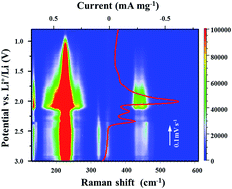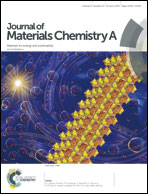Direct impregnation of SeS2 into a MOF-derived 3D nanoporous Co–N–C architecture towards superior rechargeable lithium batteries†
Abstract
Metal–organic framework (MOF) derived cobalt- and nitrogen-doped porous carbon (Co–N–C) polyhedra are employed, for the first time, as SeS2 immobilizers (Co–N–C/SeS2). As the cathode of lithium–sulfur (Li–S) batteries, the Co–N–C/SeS2 composite with a high loading (66.5 wt%) of SeS2 delivers a reversible capacity of 1165.1 mA h g−1 and an over 84.1% capacity retention of the initial capacity (970.2 mA h g−1) with a nearly 100% coulombic efficiency after 200 cycles. The Co–N–C/SeS2 cathode shows excellent rate performances with capacities of 760 mA h g−1, 604.1 mA h g−1, and 439.7 mA h g−1 at 1C, 2C, and 4C, respectively. The redox chemistry of SeS2 is revealed by in situ Raman spectroscopic analysis and density functional theory (DFT) simulations. The superior electrochemical performance of the cathode is attributed to the unique Co–N–C structure with abundant micropores and uniformly-embedded ultrafine Co nanoparticles, which provide abundant SeS2 absorption and catalytically active sites and efficiently prevent the dissolution of polysulfides and polyselenides. The conductive Co–N–C framework facilitates fast electron and ion transfer in electrochemical reactions. Our work facilitates the development of high-performance cathodes for Li–S batteries.



 Please wait while we load your content...
Please wait while we load your content...